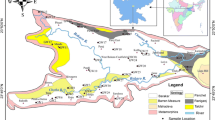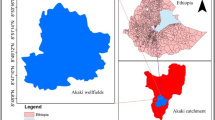Abstract
Impacts on groundwater were carried out of an open pit coal mining area located in Phulbari under Dinajpur District in Bangladesh. The exploration of coal following the open pit method will influence the groundwater resources in and around the mine due to pumping of groundwater as well as precipitated water which will be accumulated in the floor of the open pit mine. Groundwater is the main source for agriculture and domestic use of that region. For qualitative analysis four water samples out of eight showed high contamination level (Cd > 3) ranging between 4.613–8.619 (6.6), two samples showed medium contamination level (Cd = 1–3) ranging between 2.171–2.785 and two samples showed the low contamination level (Cd < 1) ranging between 0.506–0.952 value before mining activities. After mining activities the predicted concentration index for groundwater samples will show the very high contamination level (Cd > 3) ranging between 155.868–1627.256. Before mining activities Cd ranged between 0.51–8.62 and HPI ranged between 2.04–4.42, but after mining activities Cd values are expected to be 155.86–1649.7 and HPI ranges between 22.53–204.58. The DRASTIC vulnerability index is computed for evaluation of three conditions (conventional DRASTIC, Modified DRASTICCdHPI for before and after mining activities). For conventional DRASTIC the vulnerability index is found ranging from 81–167 of which 31% area is high vulnerable. Before mining activities the vulnerability index was found ranging from 87–182 of which 30% area was high vulnerable but after mining activities the vulnerability index will be found ranging from 185–375 of which 24% area will be high vulnerable, 35% will be very high vulnerable and 41% will be extreme vulnerable. Selected eight heavy metals were analyzed using AAS. The prediction is done by following the data of Raniganj coal field, Maharashtra coal fired power plant in India and Poltegor coalmine, Poland. Two methods such as contamination index (Cd) and heavy metal pollution index (HPI) were used to evaluate the contamination levels. The software used for this study is Arcview 3.3 for the preparation of location map and DRASTIC vulnerability maps. The groundwater vulnerability assessment was done using DRASTIC model in GIS environment.
Similar content being viewed by others
References
Abdullah, T.O., Ali, S.S., Al-Ansari, N.A., and Knutsson, S., 2015, Groundwater vulnerability mapping using lineament density on standard DRASTIC model: Case study in Halabja Saidsadiq Basin, Kurdistan region, Iraq. Engineering, 7, 644–667.
Aller, L., Bennet, T., Lehr, J.H., Petty, R.J., and Hackett, G., 1987, DRASTIC: A standardized system for evaluating groundwater pollution potential using hydrogeological settings. US Environmental Protection Agency, Ada, p. 2–87.
Al-Rawabdeh, A.M., Nadhir, A., Al-Ansari, Ahmed, A., Al-Taani, and Knutsson, S., 2013, A GIS-based DRASTIC model for assessing aquifer vulnerability in Amman-Zerqa groundwater Basin, Jordan. Engineering, 5, 490–504.
Al-Zabet, T., 2002, Evaluation of aquifer vulnerability to contamination potential using the DRASTIC method. Environmental Geology, 43, 203–208.
Assaf, H. and Saadeh, M., 2009, Geostatistical assessment of groundwater nitrate contamination with reflection of DRASTIC vulnerability assessment: The case of the upper Litani Basin, Lebanon. Water Resource Management, 23, 775–796.
Asia Energy Corporation (AEC) (Bangladesh) Pty Ltd, 2005, Phulbari coal project, life of mine plan. Draft report-4, 98 p.
Asia Energy Corporation (AEC) (Bangladesh) Pty Ltd, 2006, Executive summary. Final Report, 50 p.
Awawdeh, M.M. and Jaradat, R.A., 2010, Evaluation of aquifers vulnerability to contamination in the Yarmouk River basin, Jordan, based on DRASTIC method. Arabian Journal of Geoscience, 3, 273–282.
Baalousha, H., 2006, Vulnerability assessment for the Gaza Strip, Palestine using DRASTIC. Environmental Geology, 50, 405–414.
Backman, B., Bodis, D., Lahermo, P., Rapant, S., and Tarvainen, T., 1998, Application of a groundwater contamination index in Finland and Slovakia. Environmental Geology, 36, 55–64.
Carlson, C. A., 1990, Subsurface leachate migration from a reject coal pile in South Carolina. Water, Air, and Soil Pollution, 53, 345–366.
Dhar, B.B., 1993, Environmental scenario in Indian mining industry. Proceedings of the International Conference on Environmental Management, Geo-Water and Engineering Aspects, Wollongong, Feb. 8–11, p. 615–619.
Erosy, A.F. and Gultekin, F., 2013, DRASTIC-based methodology for assessing groundwater vulnerability in the Gümüshaciköy and Merzifon basin (Amasya, Turkey). Earth Sciences Research Journal, 17, 33–40.
Hearne, G.A., Wireman, M., Campbell, A., Turner, S., and Ingersoll, G.P., 1995, Vulnerability of the uppermost groundwater to contamination in the Greater Denver Area, Colorado. Water Resources Investigations Report 92-4143, Colorado Department of Health, U.S. Environmental Protection Agency and the U.S. Soil Conservation Service, 244 p.
Hoque, M.A., Hoque, M.M., and Ammed, K.M., 2007, Declining groundwater level and aquifer dewatering in Dhaka metropolitan area, Bangladesh: causes and quantification. Hydrology Journal, 15, 1523–1534.
Horton, R.K., 1965, An index systems for rating water quality. Journal of Water Pollution Control Federation, 3, 300–307.
Jamrah, A., Futaisi, A.A., Rajmohan, N., and Al-Yaroubi, S., 2008, Assessment of groundwater vulnerability in the coastal region of Oman using DRASTIC index method in GIS environment. Environmental Monitoring Assessment, 147, 125–138.
Klug, J., 2009, Modeling the risk of groundwater contamination using DRASTIC and geographic information system in Houston Country, Minnesota. Papers in Resources Analysis-11, Saint Mary’s University of Minnesota University Central Services Press, Winona, 12 p.
Lee, S., 2003, Evaluation of waste disposal site using the DRASTIC system in southern Korea, Environmental Geology, 44, 654–664.
Libicki, J., 1982, Changes in the groundwater due to surface mining. International Journal of Mine Water, 1, 25–30.
Mohan, S.V., Nithila, P., and Reddy, S.J., 1996, Estimation of heavy metal in drinking water and development of heavy metal pollution index. Journal of Environmental Science and Health, 31, 283–289.
Nalawade, P.M., Bholay, A.D., and Mule, M.B., 2012, Assessment of groundwater and surface water quality indices for heavy metal nearby area of Parli Thermal Power Plant. Universal Journal of Environmental Research and Technology, 2, 47–51.
Prasad, B. and Jaiprakas, K.C., 1999, Evaluation of heavy metals in ground water near mining area and development of heavy metal pollution index. Journal of Environmental Science and Health, 34, 91–102.
Prasad, B. and Sangita, K., 2008, Heavy metal pollution index of ground water of an abandoned open cast mine filled with fly ash: a case study. Mine Water and the Environment, 27, 265–267.
Rahman, A., 2008, A GIS based DRASTIC model for assessing groundwater vulnerability in shallow aquifer in Aligarh, India. Applied Geography, 28, 32–53.
Reddy, S.J., 1995, Encyclopedia of environmental pollution and control. Environmental Media, Karlla, 342 p.
Sener, E., Sener, S., and Davraz, A., 2009, Assessment of aquifer vulnerability based on GIS and DRASTIC methods: a case study of Senirkent- Uluborlu basin (Isparta, Turkey). Hydrogeology Journal, 17, 2023–2035.
Singh, A.K., Mahato, M., Neogi, B., and Singh, K.K., 2010, Quality assessment of mine water in the Raniganj coalfield area, India. Mine Water and the Environment, 29, 248–262.
Tiwary, R.K., 2001, Environmental impact of coal mining on water regime and its management. Water, Air, and Soil Pollution, 132, 185–199.
Thirumalaivasan, D., Karmegam, M., and Venugopal, K., 2003, AHPDRASTIC: software for specific aquifer vulnerability assessment using DRASTIC model and GIS. Environmental Modelling & Software, 18, 645–656.
Umar, R., Ahmed I,., and Alam, F., 2009, Mapping groundwater vulnerable zones using modified DRASTIC approach of an alluvial aquifer in parts of Central Ganga Plain, Western Uttar Pradesh. Journal of the Geological Society of India, 73, 193–201.
United States Environmental Protection Agency, USEPA, 1985, DRASTIC: a standard system for evaluating groundwater potential using hydrogeological settings. WA/EPA Series, Washington, DC, 163 p.
Voudouris, K., Kazakis, N., Polemio, M., and Kareklas, K., 2010, Assessment of intrinsic vulnerability using the DRASTIC model and GIS in the Kiti aquifer, Cyprus. European Water, 30, 13–24.
Wang, Y., Merkel, B.J., Li, Y., Ye, H., Fu, S., and Ihm, D., 2007, Vulnerability of groundwater in quaternary aquifers to organic contaminants: a case study in Wuhan city, China, Environmental Geology, 53, 479–484.
Wright, R.T. and Boorse, D.F., 2011, Environmental science toward sustainable future (11th edition). PHI Learning Private Limited, New Delhi-110001, 365 p.
Author information
Authors and Affiliations
Corresponding author
Rights and permissions
About this article
Cite this article
Haque, E., Reza, S. & Ahmed, R. Assessing the vulnerability of groundwater due to open pit coal mining using DRASTIC model: a case study of Phulbari Coal Mine, Bangladesh. Geosci J 22, 359–371 (2018). https://doi.org/10.1007/s12303-017-0054-0
Received:
Accepted:
Published:
Issue Date:
DOI: https://doi.org/10.1007/s12303-017-0054-0




